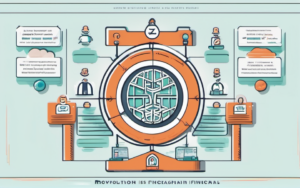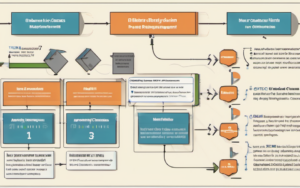Embarking on a journey into the world of blockchain investment can feel daunting, but understanding the fundamentals is key to navigating this exciting yet volatile landscape. This guide will equip you with the knowledge to make informed decisions regarding blockchain investment, focusing on minimizing risks and maximizing your potential returns.
1. Understanding Blockchain Technology
1.1 What is Blockchain?
Blockchain technology, at its core, is a decentralized, distributed ledger that records and verifies transactions across a network of computers. Think of it as a digital record-keeping system that’s incredibly secure and transparent. Unlike traditional databases controlled by a single entity, blockchain’s shared nature makes it resistant to manipulation and fraud. This fundamental characteristic is what makes it so appealing for a wide range of applications.
This distributed nature ensures that no single point of failure exists, enhancing the overall security and reliability of the system. Understanding this core principle is essential for any serious blockchain investment.
1.2 Types of Blockchain
Not all blockchains are created equal. There are primarily two types: public and private. Public blockchains, like Bitcoin, are open and accessible to everyone, offering transparency and decentralization. Private blockchains, on the other hand, are permissioned, meaning access and participation are restricted to authorized users, often prioritizing privacy and control. Understanding these differences is crucial when evaluating potential blockchain investment opportunities. For instance, a public blockchain may offer more transparency but potentially less control compared to a private one.
Knowing the type of blockchain a project uses directly impacts its potential for growth and adoption, which are essential factors to consider in your investment strategy.
1.3 How Blockchain Works
Blockchain’s functionality relies on cryptographic hashing, a complex mathematical process that links blocks of transactions together in a chronological chain. Each block contains a timestamp and a cryptographic hash of the previous block, creating an immutable record. This “chain” of blocks is replicated across multiple computers in the network, ensuring data integrity and preventing tampering. For example, a transaction on a cryptocurrency network is verified and added to a block, which then becomes part of the permanent, chronologically ordered blockchain.
This intricate process is the backbone of blockchain’s security and trust. Understanding how it works will help you appreciate the technology’s potential and identify projects with robust security mechanisms.
1.4 Advantages and Disadvantages of Blockchain
The advantages of blockchain are numerous, including enhanced security, transparency, and efficiency. Its decentralized nature reduces the risk of single points of failure and eliminates the need for intermediaries, leading to lower transaction costs. However, blockchain also has its limitations. Scalability can be a challenge, as transaction processing speeds can be slower compared to centralized systems. The energy consumption of some blockchains, particularly those using proof-of-work consensus mechanisms, is also a significant concern.
Weighing the advantages and disadvantages is vital for making informed investment decisions; a blockchain project needs to address its inherent limitations to succeed.
2. Identifying Promising Blockchain Projects
2.1 Researching the Project’s Whitepaper
Before investing in any blockchain project, thoroughly research its whitepaper. This document outlines the project’s goals, technology, tokenomics, and team. Look for clear, concise explanations of the problem being solved, the proposed solution, and the project’s overall vision. A well-written whitepaper demonstrates a well-thought-out project. A poorly written or vague whitepaper should raise red flags.
Consider its feasibility, innovation, and market potential, paying attention to the project’s roadmap and milestones.
2.2 Analyzing the Team and Advisors
The success of a blockchain project often hinges on the expertise and experience of its team and advisors. Research the backgrounds and credentials of the key individuals involved. Are they experienced developers, entrepreneurs, or industry experts? Strong leadership and a skilled team are essential indicators of a project’s potential for success.
The presence of reputable advisors can further enhance credibility and provide valuable insights.
2.3 Evaluating the Technology and Innovation
Assess the project’s underlying technology and its level of innovation. Is it utilizing a novel approach or simply replicating existing solutions? Does the technology address a real-world problem effectively? Does it offer significant improvements over existing solutions?
Look for evidence of technological advancements, patents, or unique features that set it apart from competitors.
2.4 Assessing the Market Potential and Competition
Evaluate the project’s market potential and competitive landscape. Is there a significant demand for the project’s solution? What is the level of competition in the market? Analyzing the market size and growth potential, along with the competitive landscape, is crucial for understanding the project’s long-term viability and return on investment.
Consider factors like market saturation, regulatory hurdles, and potential disruptions.
3. Investment Strategies for Blockchain Projects
3.1 Direct Investment in Cryptocurrencies
Investing directly in cryptocurrencies like Bitcoin or Ethereum is a straightforward way to participate in the blockchain ecosystem. However, this approach carries significant volatility risk, as cryptocurrency prices can fluctuate dramatically. Thorough research, including understanding market trends and technical analysis, is crucial.
Diversification is key to mitigating risk. Don’t put all your eggs in one basket.
3.2 Investing in Blockchain-Based Companies
Another approach is to invest in publicly traded companies that are involved in the blockchain industry, either through developing blockchain technology or using it in their products or services. This can offer a degree of stability compared to direct cryptocurrency investments. However, careful due diligence is still required.
Research their financials, business model, and competitive advantages.
3.3 Participating in Initial Coin Offerings (ICOs) and Security Token Offerings (STOs)
ICOs and STOs are fundraising mechanisms used by blockchain projects to raise capital. While potentially lucrative, these investments are often high-risk due to the lack of regulation and the potential for scams. Proceed with extreme caution and conduct thorough due diligence before participating.
Only invest what you can afford to lose.
3.4 Diversification and Risk Management
Diversification is crucial for managing risk in any investment portfolio, and blockchain investment is no exception. Spread your investments across different projects, asset classes, and strategies to reduce the impact of potential losses. A well-diversified portfolio can help mitigate risks while still achieving growth.
Regularly review and rebalance your portfolio to adapt to changing market conditions.
4. Risks and Considerations
4.1 Volatility of Cryptocurrency Markets
The cryptocurrency market is notoriously volatile, with prices fluctuating significantly in short periods. This volatility presents significant risk to investors, and it’s crucial to be prepared for potential losses. Consider your risk tolerance before investing.
Avoid emotional decision-making based on short-term price movements.
4.2 Regulatory Uncertainty
The regulatory landscape for blockchain and cryptocurrencies is still evolving, creating uncertainty for investors. Changes in regulations can significantly impact the value of blockchain assets. Stay informed about regulatory developments.
Consult with legal professionals to understand the implications of regulatory changes.
4.3 Security Risks and Scams
The blockchain space is susceptible to security breaches and scams. Always use reputable exchanges and wallets and be wary of unsolicited investment opportunities. Protect your assets from unauthorized access.
Use strong passwords and enable two-factor authentication.
4.4 Technological Risks
The underlying technology of blockchain projects is constantly evolving. Technological advancements or unforeseen vulnerabilities can affect the value and functionality of blockchain projects. Stay updated on technological advancements.
Consider the scalability and sustainability of the chosen projects.
5. Due Diligence and Best Practices
5.1 Thorough Research and Analysis
Before investing in any blockchain project, conduct thorough research and analysis. Understand the project’s technology, team, market potential, and risks. Don’t rely solely on marketing materials.
Verify information from multiple sources and seek independent opinions.
5.2 Understanding the Legal and Regulatory Landscape
Familiarize yourself with the legal and regulatory landscape surrounding blockchain and cryptocurrencies. Regulations vary widely across jurisdictions, and non-compliance can lead to legal consequences.
Consult with legal professionals to ensure compliance.
5.3 Secure Storage of Crypto Assets
Securely store your crypto assets using reputable hardware or software wallets. Avoid storing large amounts of cryptocurrency on exchanges. Implement robust security measures.
Protect your private keys and avoid phishing scams.
5.4 Seeking Professional Advice
Consider seeking professional advice from financial advisors or blockchain experts. They can provide valuable insights and guidance based on your individual investment goals and risk tolerance. Don’t hesitate to seek expert assistance.
This could save you from costly mistakes.
6. Building a Successful Blockchain Investment Portfolio
Building a successful blockchain investment portfolio requires a long-term vision, patience, and continuous learning. The blockchain space is constantly evolving, and staying informed about market trends and technological advancements is crucial for making informed investment decisions. Be prepared for market corrections and don’t panic-sell during downturns. Remember, successful investing is a marathon, not a sprint. By diligently following these guidelines and adapting to the ever-changing landscape, you can significantly increase your chances of success in this exciting field. Remember that this information is for educational purposes only and not financial advice. Always conduct your own thorough research and seek professional guidance before making any investment decisions.




